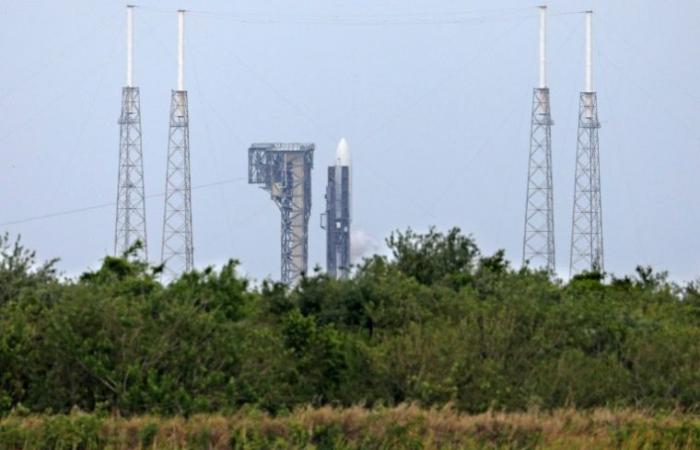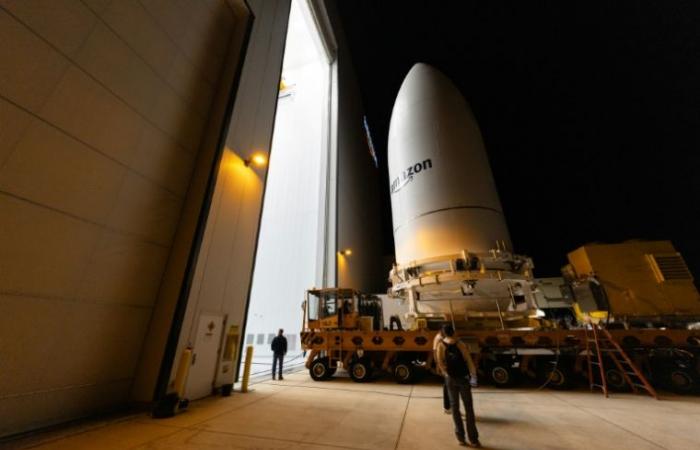
An Atlas V rocket of the United Launch Alliance group (ULA) at Kennedy space Center in Cap Canaveral, Florida, April 9, 2025 (AFP / Gregg Newton)
The Amazon company of the wealthy Jeff Bezos launched the first satellites of its Kuiper constellation on Monday on Monday, which aims to offer a very high speed internet connection from space and compete with the giant starlink of another multimillionaire, Elon Musk.
With several years behind his rival, the American giant of online sales sent several hundred kilometers above the earth the first 27 satellites of this network supposed to count more than 3,200 in the long term.
The takeoff of the Atlas V rocket of the United Launch Alliance group (ULA), which brings together Boeing and Lockheed Martin, carrying the satellites took place at 7:01 p.m. local (11:01 p.m. GMT) in Cap Canaveral (Florida).
The devices transported in space set the milestones of the “Kuiper project”, an infrastructure with both commercial, technological and geopolitical issues.
Amazon, which has invested more than $ 10 billion there, aims to offer very high speed internet access to this globe points, including remote areas and war areas, thanks to this network of satellites, including all points of the globe or victims.
The service should be set up during 2025. Its cost is still unknown but should however be “accessible”, according to Amazon, which wants to keep the recipe that has made its success: broken prices.
– advance length –
This promise is reminiscent of that of Elon Musk. With his Starlink constellation, the richest man in the world dominates the booming market of the internet by satellites and has a good step ahead, as in the field of rockets where Jeff Bezos and he competes with him.

Photo broadcast by Amazon, April 2, 2025, showing the satellites of the Kuiper project encapsulated in the cap of an Atlas V rocket at the Amazon satellite treatment center in Cap Canaveral, Florida, in March 2025 (Amazon / -)
Started several years ago, Starlink succeeded in the night from Sunday to Monday to 250th launch and has more than 6,750 satellites in orbit.
Its services were notably deployed on land affected by natural disasters, as in September 2023 during an earthquake in Morocco, in January this year after fires in Los Angeles but also on the front in Ukraine.
Unlike traditional satellite telecommunications services, which are based on less numerous but larger and larger machines located more than 35,000 km from the earth, those offered by Elon Musk and Jeff Bezos operate in low orbit, which allows them to exchange much faster data.
Their architecture – satellites communicating on the ground with small mobile antennas – also makes it possible to cover areas where “cost, complexity and geography” make “difficult to install traditional soil connectivity solutions”, explains Amazon.
– Sovereignty –
In order to catch up on competition, Jeff Bezos intends to deploy the rest of its constellation in the coming months and years, with more than 80 flights ordered from various space companies including ULA and Arianespace, but also Blue Origin, its own company, and even SpaceX, that of Elon Musk.
These thousands of satellites will be gradually distributed over the low terrestrial orbit, a space already occupied by the machines of Starlink and those of a growing number of actors, including the European operator Eutelsat, which merged in 2023 with Oneweb, or China with its Guowang constellation.
Competition brought to grow and which presents a number of issues, especially in terms of security. This multitude of devices thus raises fears of a sharing of the low terrestrial orbit and possible collisions, but also disturbances of astronomical observations.
It also raises questions of sovereignty. In this area, the increased political role played by Elon Musk, who became a close advisor to Donald Trump, recently revived the debates on the need not to leave space in the hands of private actors.










